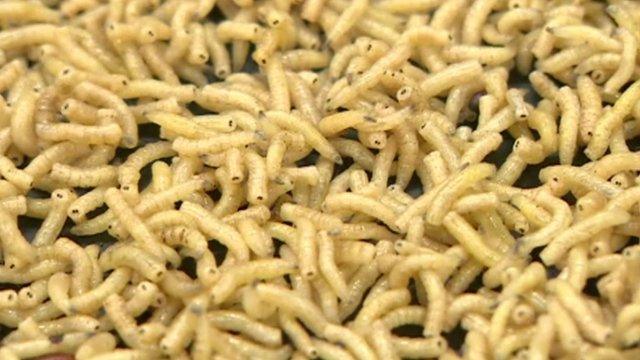How maggots can lower Kenyan hospital bills
- Published
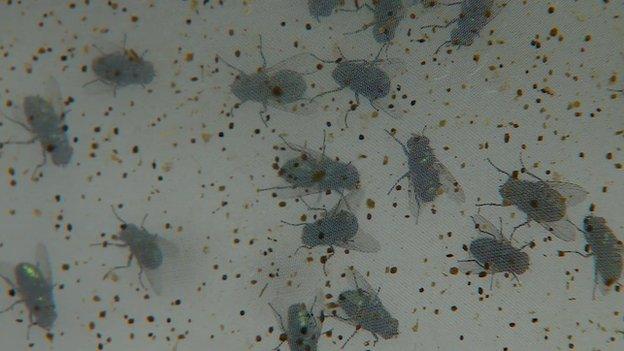
The maggots hatch from eggs laid by green bottle flies
Patients in Kenya may soon start receiving live maggots as a treatment after promising results from a pilot study using the age-old practice.
In a country where many people have to pay for their medication, the method of healing infected flesh wounds with fly larvae also promises to lower medical bills.
"The results were good; patients who were to stay here for three months and go through surgery while using expensive antibiotics were able to leave hospital in two to three weeks," says Dr Christopher Kibiwot, who took part in the trial at the Kenyatta National Hospital.
Maggot therapy dates back to early civilisations.
But with the discovery of penicillin and the development of antibiotics in the 20th Century, modern medicine dropped it as the treatment of choice in hospitals.
With resistance to antibiotics now a growing challenge, doctors are looking at alternatives.
"Basically maggots feed on dead tissue, what we call necrotic tissue," explains Dr Kibiwot.
"By so doing they compete with bacteria for food… so the bacteria will not grow. That's one way of achieving the healing of the wound without use of antibiotics."
To produce the maggots, colonies of the green bottle fly are kept at the Kenya Agricultural Research Institute (Kari).

Maggot therapy:

First reported use was by the ancient Maya civilisation in central America and Aboriginal communities in Australia
Doctors during the US Civil War noticed their efficacy in neglected wounds of injured soldiers
The fly larvae feast on dead flesh
They excrete an enzyme that softens the dead tissue
Their use in cleaning wounds declined after the development of antibiotics
In 2004, the US Food and Drug Administration allowed the breeding of maggots for medicinal use

Phoebe Mukiria, an entomologist at Kari who oversees the maggot production, says the reason they are so "special" is that they just feed on dead tissue.
"It cleans the wound and will not go on to eat live tissue so you don't feel any pain," she says.
'Micro-surgeons'
In essence, Ms Mukiria says the maggots turn the dead tissue into liquid, which they are able to suck up as food.
Maggots compete with bacteria to eat infected areas leaving them clean, as Anne Soy reports
They do this by excreting saliva containing special chemicals onto the wound, she says.
"They are called micro-surgeons because they are able to reach where surgeons are not able to reach," Ms Mukiria says.
The flies at Kari are kept in a cubed cage covered with a see-through net and fed on bran and sugar; sponges soaked in water are also placed inside.
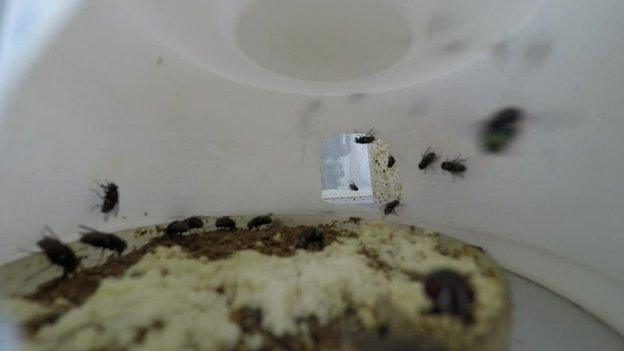
The flies lay their eggs in a dish filled with ground cow's liver
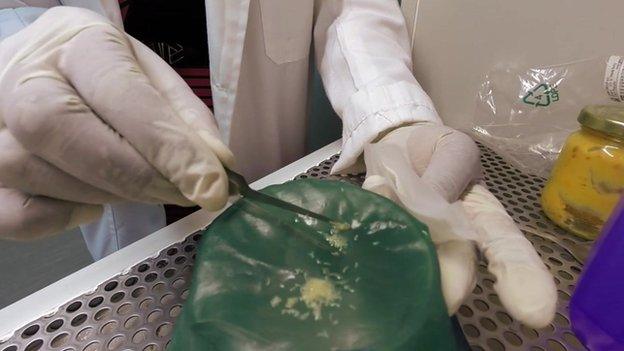
After the eggs hatch, the larvae are disinfected and transferred to a small sachet
The sated flies are then ready to lay their eggs, which they do about three times a week, usually in a carcass or some form of decaying flesh.
So Ms Mukiria introduces into the cage a dish of ground cow's liver and covers it with a plastic bowl that has two holes on opposite sides.
After two hours, she removes it and the liver is now covered with cream-coloured eggs.
The eggs are then sterilised in sodium hypochlorite and then incubated for 24 hours, during which time the tiny 1mm- (0.04in-) long maggots are hatched.
Within hours they are washed again and packed in sachets, which resemble tea bags.
These are placed in a cool box ready for delivery to the hospital.
"If kept cold they can live for 24 hours so we are sure to get them to far-away hospitals," says Ms Mukiria.
'Fear factor'
At the Kenyatta National Hospital in the capital, Nairobi, Dr Kibiwot has prepared one of his patients - Hannah Wagio - for the therapy as she has been unable to afford antibiotics.
Some patients are rather sceptical about the treatment at first, he says.
"Initially, of course, there is that fear factor: 'Why are you putting maggots in me while I'm still alive?'

After two days of maggot treatment, Hannah Wagio said her pain eased

The small sachet containing the maggots looks swollen when it is removed from the wound after two days
"But after explaining to them the outcome and that it will reduce their hospital stay by far, they are ready to try anything."
Ms Wagio, who has bed sores on her heels that have left her unable to walk, is willing to give it a go.
She wriggles in pain as the doctor cleans the wounds - part of the skin is hanging from the heel surrounded by pus.
Dr Kibiwot then places a sachet of maggots on each wound and applies some dressing.
"I'm being careful not to tape over the area with the maggots because they could suffocate," he says as he finishes wrapping the bandages.
'Exciting'
Two days later, when it is time to remove them, Ms Wagio appears upbeat.
She says the pain has gone and smiles as the doctor undoes the dressing.
The wounds appear clean and dry, and the sachets of maggots have swelled.
Opening one of them on the palm of his gloved hand, Dr Kibiwot shows how much bigger and fatter the maggots have grown.

Kenyan health costs:
A bed in a state hospital costs about $10 a day
Many patients have to pay for medication
46% of Kenya's 42.7 million people live on less than $1.25 a day
The majority of patients who come to Kenyatta National Hospital, the country's main referral hospital, are unemployed
Civil servants are covered by government-backed insurance scheme
Private health insurance is available for those that can afford it

Ms Wagio says she asked for assurances that all the maggots had been removed.
"I was worried they may eat me up later, but he told me none remain in there," she says.
For patients like Ms Wagio the therapy means lower medical bills, a shorter stay in hospital and concern about resistance to antibiotics is not an issue.
"I'm happy to get this and I'll continue to get this until I get healed. And when I'm healed others will hopefully use this therapy also," she says.
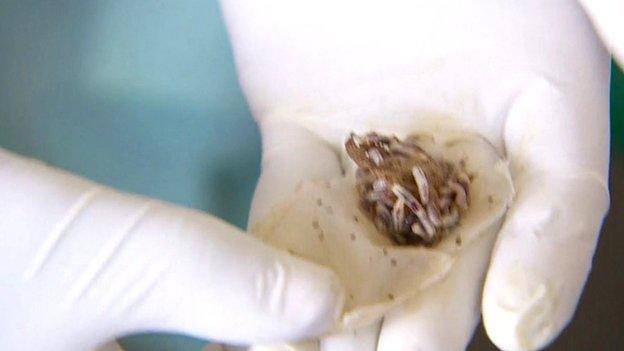
The maggot bag - opened after it is removed from the wound - shows the larvae have grown
Results from the pilot study in Kenya - funded by SlovakAid - are under evaluation.
But word has spread across the country and Kari is already receiving calls from patients asking for the low-cost maggots.
Nearly 20 countries around the world are already using maggot therapy, including the US and the UK, which recognised it as a medical treatment in 2004.
"It was a very exciting project because it is new and it's unbelievable," says Ms Mukiria.
"But once we got the first two or three people [treated], now the patients are the ones who want to be on it."
And she says her laboratory has all it takes to supply enough maggots across the country.
- Published4 July 2023
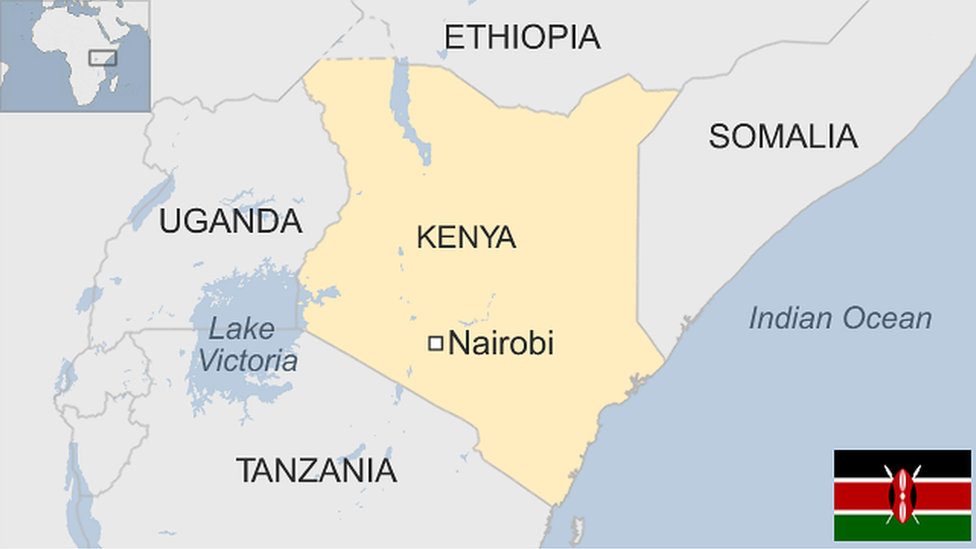
- Published13 August 2014
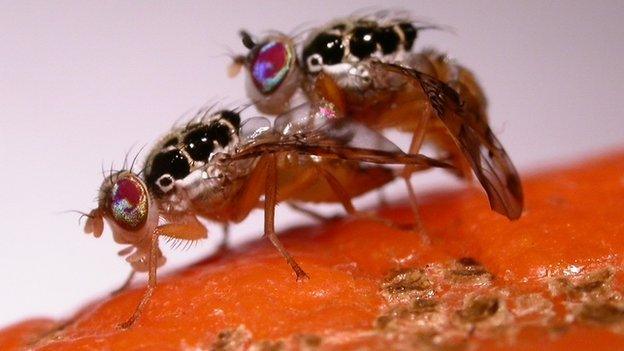
- Published17 April 2014
